Stacked Bar Chart
With the stacked version of the bar, compare subcategories across groups. Try not to show too many subcategories though, or it’ll clutter quick.

With the stacked version of the bar, compare subcategories across groups. Try not to show too many subcategories though, or it’ll clutter quick.
